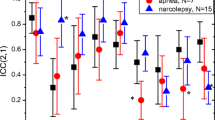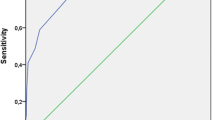Abstract
Purpose
Disorders of arousal include confusional arousals, sleepwalking and sleep terrors. The diagnosis of disorders of arousal is based on the clinical criteria established in the International Classification of Sleep Disorders, third edition, although the interobserver reliability of these criteria has never been investigated. The aim of this study was to estimate the inter-rater reliability of the diagnostic criteria for disorders of arousal throughout the whole life in order to understand their feasibility in clinical daily activity and in multicenter observational studies.
Methods
Three raters interviewed 126 subjects (patients complaining of sleep disorders, headache, and healthy subjects), aged 18–80 years, with a standardized questionnaire created by applying the International Diagnostic Criteria for Disorders of Arousal.
Results
An “almost perfect” inter-rater reliability for disorders of arousal criteria and the final diagnosis was found among the raters (kappa 0.89 for confusional arousals, 0.87 for sleepwalking, and 0.87 for sleep terrors).
Conclusions
The International Classification of Sleep Disorders, Third Edition criteria are adequate for a reliable diagnosis of disorders of arousal. Further validation studies, confirming DOA diagnosis with video polysomnography, are needed to investigate the predictive value of ICSD-3 criteria.
Similar content being viewed by others
References
American Academy of Sleep Medicine. The International Classification of Sleep Disorders, Third Edition (American Academy of Sleep Medicine, 2014).
Pressman MR (2007) Factors that predispose, prime and precipitate NREM parasomnias in adults: clinical and forensic implications. Sleep Med Rev 11:5–30
Bassetti C, Vella S, Donati F, Wielepp P, Weder B (2000) SPECT during sleepwalking. Lancet. 356(9228):484–485
Broughton RJ (1968) Sleep disorders: disorders of arousal? Enuresis, somnambulism, and nightmares occur in confusional states of arousal, not in “dreaming sleep”. Science (New York, NY) 159:1070–1078
Stores G (2009) Aspects of parasomnias in childhood and adolescence. Arch Dis Child 94:63–69
Klackenberg G (1982) Somnambulism in childhood--prevalence, course and behavioral correlations. A prospective longitudinal study (6-16 years). Acta Paediatr Scand 71:495–499
Laberge L, Tremblay RE, Vitaro F, Montplaisir J (2000) Development of parasomnias from childhood to early adolescence. Pediatrics. 106:67–74
Ohayon MM, Guilleminault C, Priest RG (1999) Night terrors, sleepwalking, and confusional arousals in the general population: their frequency and relationship to other sleep and mental disorders. J Clin Psychiatry 60:268–276
Bjorvatn B, Grønli J, Pallesen S (2010) Prevalence of different parasomnias in the general population. Sleep Med 11:1031–1034
Hublin C, Kaprio J, Partinen M, Heikkilä K, Koskenvuo M (1997) Prevalence and genetics of sleepwalking: a population-based twin study. Neurology. 48:177–181
Hublin C, Kaprio J (2003) Genetic aspects and genetic epidemiology of parasomnias. Sleep Med Rev 7:413–421
Moreno MA (2015) Sleep terrors and sleepwalking. JAMA Pediatr 169:704
Ohayon MM, Mahowald MW, Dauvilliers Y, Krystal AD, Léger D, Leger D (2012) Prevalence and comorbidity of nocturnal wandering in the US adult general population. Neurology. 78:1583–1589
Stallman HHM, Kohler M, Broughton R, Sadeh A, Mume C, Baddeley A et al (2016) Prevalence of sleepwalking: a systematic review and meta-analysis. PLoS One 11:e0164769
Moldofsky H, Gilbert R, Lue FA, MacLean AW (1995) Sleep-related violence. Sleep. 18:731–739
Schenck CH, Milner DM, Hurwitz TD, Bundlie SR, Mahowald MW (1989) A polysomnographic and clinical report on sleep-related injury in 100 adult patients. Am J Psychiatry 146:1166–1173
Bisulli F, Vignatelli L, Naldi I, Pittau F, Provini F, Plazzi G et al (2012) Diagnostic accuracy of a structured interview for nocturnal frontal lobe epilepsy (SINFLE): a proposal for developing diagnostic criteria. Sleep Med 13:81–87
Licchetta L, Bisulli F, Vignatelli L, Zenesini C, Di Vito L, Mostacci B et al (2017) Sleep-related hypermotor epilepsy. Neurology. 88:70–77
Provini F, Plazzi G, Tinuper P, Vandi S, Lugaresi E, Montagna P (1999) Nocturnal frontal lobe epilepsy: a clinical and polygraphic overview of 100 consecutive cases. Brain. 122:1017–1031
Tinuper P, Provini F, Bisulli F, Vignatelli L, Plazzi G, Vetrugno R et al (2007) Movement disorders in sleep: guidelines for differentiating epileptic from non-epileptic motor phenomena arising from sleep. Sleep Med Rev 11:255–267
Plante DT, Winkelman JW (2006) Parasomnias. Psychiatr Clin N Am 29:969–987
Drakatos P, Marples L, Muza R, Higgins S, Nesbitt A, Dongol EM et al (2019) Video polysomnographic findings in non-rapid eye movement parasomnia. J Sleep Res 28(2):e12772
Fois C, Wright M-AS, Sechi G, Walker MC, Eriksson SH (2015) The utility of polysomnography for the diagnosis of NREM parasomnias: an observational study over 4 years of clinical practice. J Neurol 262(2):385–393
Lopez R, Shen Y, Chenini S, Rassu AL, Evangelista E, Barateau L et al (2018) Diagnostic criteria for disorders of arousal: a video-polysomnographic assessment: disorders of arousal. Ann Neurol 83:341–351
American Academy of Sleep Medicine (2001) International Classification of Sleep Disorders, revised: Diagnostic and Coding Manual. Rochester, Minnesota: American Academy of Sleep Medicine
Vignatelli L, Bisulli F, Zaniboni A, Naldi I, Fares JE, Provini F et al (2005) Interobserver reliability of ICSD-R minimal diagnostic criteria for the parasomnias. J Neurol 252:712–717
Kottner J, Audigé L, Brorson S, Donner A, Gajewski BJ, Hróbjartsson A et al (2011) Guidelines for reporting reliability and agreement studies (GRRAS) were proposed. J Clin Epidemiol 64:96–106
Fleiss JL, Levin B, Paik MC (2003) Statistical methods for rates and proportions. Third edition. Wiley, New York
Landis JR, Koch GG (1977) The measurement of observer agreement for categorical data. Biometrics. 33:159–174
Pilon M, Desautels A, Montplaisir J, Zadra A (2012) Auditory arousal responses and thresholds during REM and NREM sleep of sleepwalkers and controls. Sleep Med 13:490–495
Acknowledgements
The authors wish to thank Cecilia Baroncini and Anne Collins for English editing.
Funding
This research received no specific grant from any funding agency in the public, commercial, or not-for-profit sectors.
Author information
Authors and Affiliations
Corresponding author
Ethics declarations
Conflict of interest
Dr. Loddo, Dr. Vignatelli, Dr. Zenesini, Dr. Lusa, Dr. Sambati, Dr. Baldelli, Dr. Favoni, Dr. Pisani, Dr. Pierangeli, Dr. Cevoli report no disclosures. Dr. Provini received honoraria for speaking engagements or consultancies from Sanofi, Bial, Fidia, Vanda Pharmaceutical, Zambon, Eisai Japan, Italfarmaco.
Ethical approval
All procedures performed in this study involving human participants were in accordance with the ethical standards of the institutional and national research committee (Bologna-Imola Ethics Committee, no. 17175) and with the 1964 Helsinki declaration and its later amendments or comparable ethical standards.
Informed consent
Informed consent was obtained from all individual participants included in the study.
Additional information
Publisher’s note
Springer Nature remains neutral with regard to jurisdictional claims in published maps and institutional affiliations.
Rights and permissions
About this article
Cite this article
Loddo, G., Vignatelli, L., Zenesini, C. et al. Interobserver reliability of ICSD-3 diagnostic criteria for disorders of arousal in adults. Sleep Breath 23, 1309–1314 (2019). https://doi.org/10.1007/s11325-019-01937-w
Received:
Revised:
Accepted:
Published:
Issue Date:
DOI: https://doi.org/10.1007/s11325-019-01937-w




